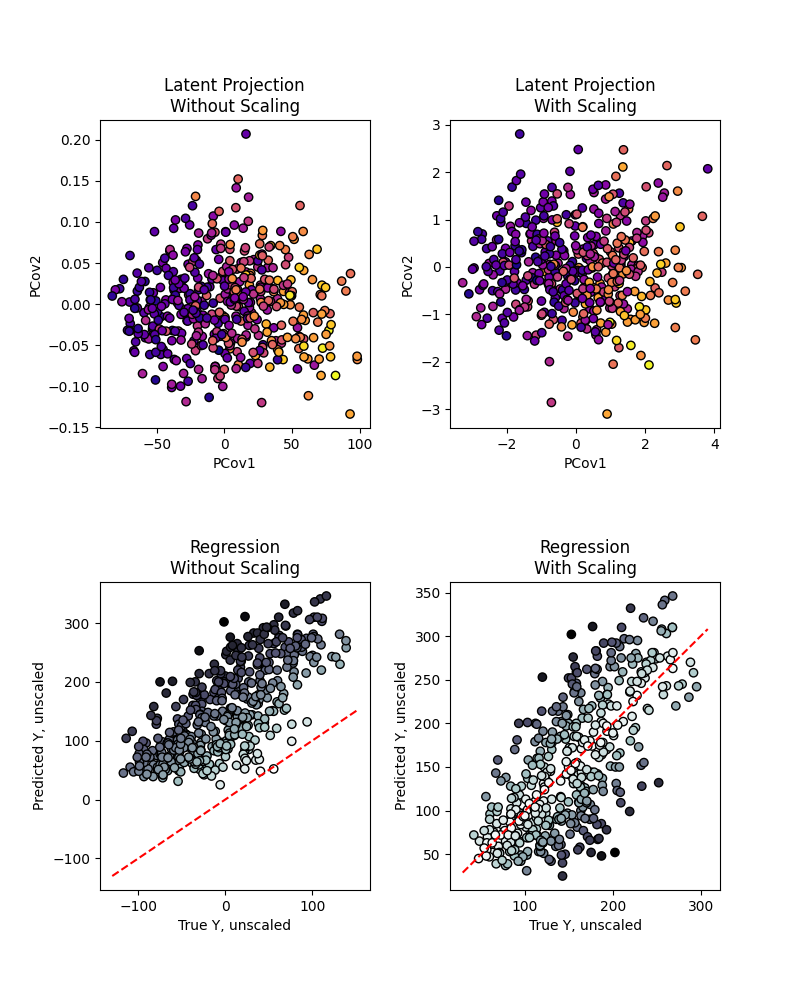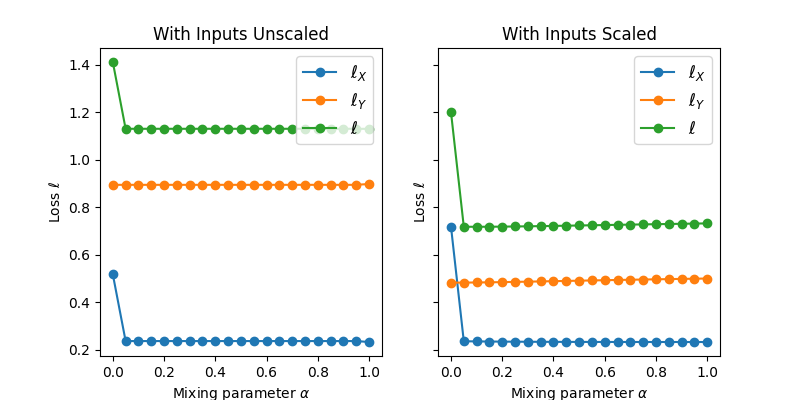Note
Go to the end to download the full example code.
The Importance of Data Scaling in PCovR / KernelPCovR#
import numpy as np
from matplotlib import pyplot as plt
from sklearn.datasets import load_diabetes
from sklearn.preprocessing import StandardScaler
from skmatter.decomposition import PCovR
In PCovR, and KernelPCovR, we are combining multiple aspects of the dataset, primarily the features and targets. As such, the results largely depend on the relative contributions of each aspect to the mixed model.
X, y = load_diabetes(return_X_y=True)
Take the diabetes dataset from sklearn. In their raw form, the magnitudes of the features and targets are
print(
"Norm of the features: %0.2f \nNorm of the targets: %0.2f"
% (np.linalg.norm(X), np.linalg.norm(y))
)
Norm of the features: 3.16
Norm of the targets: 3584.82
For the California dataset, we can use the StandardScaler class from sklearn, as the features and targets are independent.
x_scaler = StandardScaler()
y_scaler = StandardScaler()
X_scaled = x_scaler.fit_transform(X)
y_scaled = y_scaler.fit_transform(y.reshape(-1, 1))
Looking at the results at mixing=0.5, we see an especially large difference in the
latent-space projections
pcovr_unscaled = PCovR(mixing=0.5, n_components=4).fit(X, y)
T_unscaled = pcovr_unscaled.transform(X)
Yp_unscaled = pcovr_unscaled.predict(X)
pcovr_scaled = PCovR(mixing=0.5, n_components=4).fit(X_scaled, y_scaled)
T_scaled = pcovr_scaled.transform(X_scaled)
Yp_scaled = y_scaler.inverse_transform(pcovr_scaled.predict(X_scaled))
fig, ((ax1_T, ax2_T), (ax1_Y, ax2_Y)) = plt.subplots(2, 2, figsize=(8, 10))
ax1_T.scatter(T_unscaled[:, 0], T_unscaled[:, 1], c=y, cmap="plasma", ec="k")
ax1_T.set_xlabel("PCov1")
ax1_T.set_ylabel("PCov2")
ax1_T.set_title("Latent Projection\nWithout Scaling")
ax2_T.scatter(T_scaled[:, 0], T_scaled[:, 1], c=y, cmap="plasma", ec="k")
ax2_T.set_xlabel("PCov1")
ax2_T.set_ylabel("PCov2")
ax2_T.set_title("Latent Projection\nWith Scaling")
ax1_Y.scatter(Yp_unscaled, y, c=np.abs(y - Yp_unscaled), cmap="bone_r", ec="k")
ax1_Y.plot(ax1_Y.get_xlim(), ax1_Y.get_xlim(), "r--")
ax1_Y.set_xlabel("True Y, unscaled")
ax1_Y.set_ylabel("Predicted Y, unscaled")
ax1_Y.set_title("Regression\nWithout Scaling")
ax2_Y.scatter(
Yp_scaled, y, c=np.abs(y.ravel() - Yp_scaled.ravel()), cmap="bone_r", ec="k"
)
ax2_Y.plot(ax2_Y.get_xlim(), ax2_Y.get_xlim(), "r--")
ax2_Y.set_xlabel("True Y, unscaled")
ax2_Y.set_ylabel("Predicted Y, unscaled")
ax2_Y.set_title("Regression\nWith Scaling")
fig.subplots_adjust(hspace=0.5, wspace=0.3)

Also, we see that when the datasets are unscaled, the total loss (loss in recreating
the original dataset and regression loss) does not vary with mixing, as expected.
Typically, the regression loss should _gradually_ increase with mixing
(and vice-versa for the loss in reconstructing the original features). When the
inputs are not scaled, however, only in the case of mixing = 0 or 1 will the
losses drastically change, depending on which component is dominating the model.
Here, because the features dominate the model, this jump occurs as mixing goes to
0. With the scaled inputs, there is still a jump when mixing>0 due to the change
in matrix rank.
mixings = np.linspace(0, 1, 21)
losses_unscaled = np.zeros((2, len(mixings)))
losses_scaled = np.zeros((2, len(mixings)))
nc = 4
for mi, mixing in enumerate(mixings):
pcovr_unscaled = PCovR(mixing=mixing, n_components=nc).fit(X, y)
t_unscaled = pcovr_unscaled.transform(X)
yp_unscaled = pcovr_unscaled.predict(T=t_unscaled)
xr_unscaled = pcovr_unscaled.inverse_transform(t_unscaled)
losses_unscaled[:, mi] = (
np.linalg.norm(xr_unscaled - X) ** 2.0 / np.linalg.norm(X) ** 2,
np.linalg.norm(yp_unscaled - y) ** 2.0 / np.linalg.norm(y) ** 2,
)
pcovr_scaled = PCovR(mixing=mixing, n_components=nc).fit(X_scaled, y_scaled)
t_scaled = pcovr_scaled.transform(X_scaled)
yp_scaled = pcovr_scaled.predict(T=t_scaled)
xr_scaled = pcovr_scaled.inverse_transform(t_scaled)
losses_scaled[:, mi] = (
np.linalg.norm(xr_scaled - X_scaled) ** 2.0 / np.linalg.norm(X_scaled) ** 2,
np.linalg.norm(yp_scaled - y_scaled) ** 2.0 / np.linalg.norm(y_scaled) ** 2,
)
fig, (ax1, ax2) = plt.subplots(1, 2, figsize=(8, 4), sharey=True, sharex=True)
ax1.plot(mixings, losses_unscaled[0], marker="o", label=r"$\ell_{X}$")
ax1.plot(mixings, losses_unscaled[1], marker="o", label=r"$\ell_{Y}$")
ax1.plot(mixings, np.sum(losses_unscaled, axis=0), marker="o", label=r"$\ell$")
ax1.legend(fontsize=12)
ax1.set_title("With Inputs Unscaled")
ax1.set_xlabel(r"Mixing parameter $\alpha$")
ax1.set_ylabel(r"Loss $\ell$")
ax2.plot(mixings, losses_scaled[0], marker="o", label=r"$\ell_{X}$")
ax2.plot(mixings, losses_scaled[1], marker="o", label=r"$\ell_{Y}$")
ax2.plot(mixings, np.sum(losses_scaled, axis=0), marker="o", label=r"$\ell$")
ax2.legend(fontsize=12)
ax2.set_title("With Inputs Scaled")
ax2.set_xlabel(r"Mixing parameter $\alpha$")
ax2.set_ylabel(r"Loss $\ell$")
fig.show()

Note: When the relative magnitude of the features or targets is important, such
as in skmatter.datasets.load_csd_1000r(), one should use the
skmatter.preprocessing.StandardFlexibleScaler.